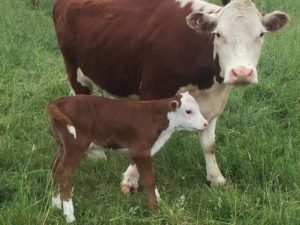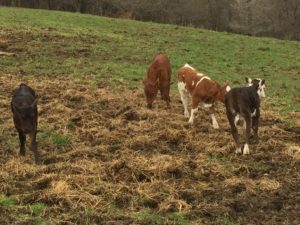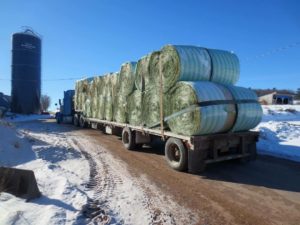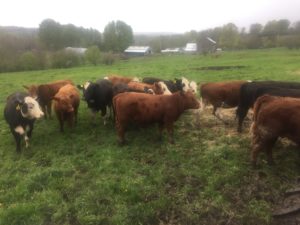Preparing Your Beef Cows for Springtime Calving
In part eight of our “What’s Your Beef?” series on raising cattle on small farms, we share why you need to be paying strict attention to the quality of feed that your late gestation beef cows receive just prior to calving season.
This article is the eighth installment on raising and managing beef cattle in the Small Farms Quarterly. Previous articles can all be accessed through the Quarterly Archives tab of the Cornell Small Farms website.

Good nutrition for late pregnancy cows will ensure healthy calves like this one on the author’s farm.
Rich Taber / CCE Chenango
Beef cattle have a gestation period of about nine months, or around 287 days. It is during the last trimester of pregnancy that the animals need a sharp increase in the quality of their nutrition. The energy and protein needs of pregnant beef mothers to be increase dramatically just prior to calving. If we overlook this important time, calves can be born weaker and stand a lower chance of survival, and with poorer chances of growing at a rate that we would like to see. Well then, how do we go about this? In a nutshell, it mostly rests on the quality of the dry or high moisture hay products that you are feeding, (dry hay or high moisture baleage). A beef cow will typically eat around 25-30 pounds of dry hay equivalent a day, and roughly double that amount in weight of high moisture hay, or baleage. We can get along just fine during the first and second trimester of pregnancy with our average quality hay that we either made ourselves or have purchased. During the final trimester of pregnancy, however, is when we need to bring out the higher quality goods that we have on hand. This is especially true if we are of a grass-fed only persuasion; we might not have the luxury of feeding a little grain. If we are not strictly grass fed, and need to ramp up the animals’ nutrition, then perhaps a bit of grain to supplement their rations may be in order if the hay lacks a bit in quality.

Happy, healthy well fed calves as a result of maternal nutrition on the author’s farm. Rich Taber / CCE Chenango
Ideally, by calving in the springtime, say from April-May onward, the cows can avail themselves of high-quality grass pasture which is excellent for milk production and getting those calves to grow like gangbusters. Just prior to this time is the last trimester of pregnancy, and we will probably still be feeding stored forages. We need to be paying lots of attention to the quality of forages that the cows are receiving.
We need to get away from the mentality of “beef quality, or heifer hay”. This is a ploy sometimes used by people selling hay that is of too low a quality for milking dairy cattle.

You may need to buy some good dairy quality hay for late lactation beef cows. Rich Taber / CCE Chenango
It may be later cut grass hay that may have even been rained on. Some of this can be used in the fall when cows are in the earlier stages of gestation. As the winter waxes on however, the unborn fetuses need more energy and protein. Its then a good strategy to start mixing in some of the higher quality hay that you have on hand. Then in the latter part of the gestation period, we need to be feeding the best quality hay that we can find every day. Early lactation for beef cattle demands that we keep feeding the best quality forages that we can offer until they are ready to start grazing on those lush spring grasses. If you need to purchase hay, keep in mind that all hay is not created equally. Late cut, weedy, unfertilized hay that has been left uncovered out in the field is a far cry from high quality hay or haylage/baleage that has been properly stored. Don’t be “penny wise and pound foolish” by buying low quality hay for late gestation animals! We must also be vigilant in providing salt and the correct mineral mix to the animals. Free choice minerals are to be preferred over salt and trace mineral blocks to ensure enough intake. Just a cautionary note: if you happen to also be feeding sheep, make sure that they receive minerals designed for sheep, and which has no copper in it! Don’t feed beef minerals to sheep, or they can die from copper toxicity!

Healthy calves grow into healthy, profitable yearlings like these.
Rich Taber / CCE Chenango
Nutritionally speaking, the nutrients that we need to be paying attention to are energy, which comes from carbohydrates and fats. This is typically measured using “TDN”, or total digestible nutrients. Protein is the other “biggie” and is measured as “CP”, or crude protein. It doesn’t hurt to have your hay tested for these important nutrients; that way you can portion out your lower quality stuff earlier in the season and save the “high octane” hay for late gestation. Vitamins are important too, and good quality hay generally provides enough of them, especially Vitamin D. Minerals will be provided by your free choice beef cattle mixes. Calcium and phosphorus are the two biggest minerals that are needed to ensure healthy, strong calves. Do not shortchange your animals on minerals!
Pay attention to those soon to be mothers, especially first calf heifers, and younger cows that have been bred. These types of animals are still growing and may need to be separated from the older, more aggressive cows. Pay attention to all your animals, and make sure that they are receiving adequate nutrition! The old saying goes “the eye of the Master fattens his/her cattle!”

